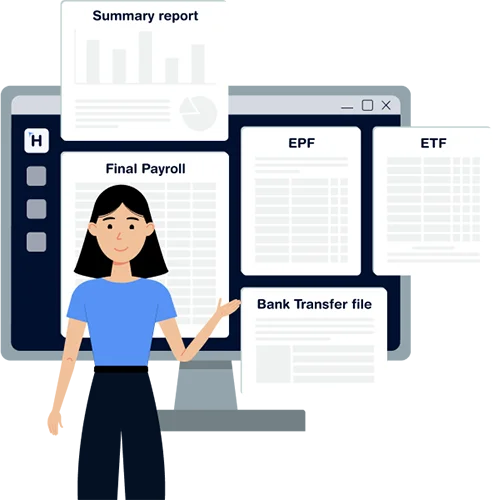Non-cash benefits have grown significantly in popularity in the current competitive environment since they not only help to determine an employee’s overall remuneration but also play a vital part in managing tax obligations and preventing brain drain. Employers can improve their capacity to attract and retain top talent by providing non-cash benefits, lowering the likelihood that qualified people will leave for better chances abroad. Additionally, keeping informed of the tax implications of these advantages assures adherence to the most recent rules imposed by the Inland Revenue Department (IRD). This proactive approach not only allows both employers and employees to optimize their tax strategies but also promotes a reliable and thriving local workforce.
This article will explore the concept of non-cash benefits, investigate how to quantify them for tax purposes, and explain how taxes work in relation to them.
What are non-cash benefits?
Non-cash benefits are valued incentives provided by employers to employees in addition to their regular monetary compensation. These benefits, which may include healthcare coverage, housing allowances, transportation, and educational assistance, play an important role in improving employee well-being and job satisfaction. Non-cash rewards have significant tax advantages. They are frequently taxed at lower rates or are even exempt, lowering the tax burden on both businesses and employees. This encourages employers to provide non-cash benefits, so increasing employee retention and loyalty, while also establishing a favorable tax environment that benefits businesses and helps to a vibrant economy.
Taxation of non-cash benefits
Non-cash benefits in Sri Lanka are subject to taxation, as the value of these benefits is considered taxable income for employees. The tax treatment of non-cash benefits varies depending on the specific benefit offered. To provide clarity and guidance, the Inland Revenue Department issued Circular No. SEC/2022/E/05 on 07.02.2023, which outlines updated guidelines for the taxation of non-cash benefits in accordance with the Income Tax Act No. 24 of 2017. These guidelines serve to ensure transparency and compliance in the taxation process for non-cash benefits in Sri Lanka.
The cost incurred by the employer in providing non-cash benefits is used to calculate their worth. For the purpose of calculating taxes, this value is added to the employee’s income.
Withholding tax is a critical aspect of adding non-cash benefits to employee compensation. Employers are responsible for deducting and remitting income tax from employees’ wages, considering the value of non-cash benefits supplied. These benefits, like healthcare coverage and housing allowances, have a monetary value for employees and are subject to taxation under Sri Lanka’s income tax regulations. Employers must calculate the tax liability by determining the cash equivalent value of the benefits and applying the relevant tax rates. Employers meet their legal commitments, contribute to a fair tax system, and guarantee employees receive the benefits they are entitled to by adhering to withholding tax requirements.
Read more about Advance Personal Income Tax (APIT) here— https://rb.gy/eeqx7
Common non-cash benefits provided in SL
Depending on the industry, the organization, and the particular employment contracts, employers may give a variety of non-cash benefits. Common non-cash benefits provided by employers in Sri Lanka include:
Hotel facilities for expatriates – Employers often provide hotel accommodations for expatriate employees in order to ensure a comfortable stay and a smooth transition. This benefit helps expatriates to concentrate on their business without having to worry about finding a place to live. 100% of the cost will be added as a non-cash benefit.
Loans on concessionary interest rates – Employees can borrow money from their employer at lower interest rates than regular bank rates. This benefit assists employees in meeting their financial demands while avoiding the stress of high-interest payments, allowing them to better manage their finances and improve their overall financial well-being. This cost will not be considered for APIT.
Electricity and gas – This refers to employers offering these utilities to employees without charging them directly. It means that the employer pays for employees’ electricity and gas expenses and 100% of the cost will be valued as a non-cash benefit.
Free meals – Employers provide complimentary meals to employees during working hours to ensure that they are well-nourished and have access to high-quality food without incurring additional costs. This also generates a sense of camaraderie and belonging inside the workplace. 100% of the cost will be calculated for APIT.
Payment of telephone bills – This non-cash benefit covers the costs of work-related phone calls, allowing employees to stay connected and productive without worrying about expenditure. Only 50% of the total cost will be included as a benefit.
Air tickets – Employers may offer employees airline tickets for work-related travel and 100% of the cost will be included as a benefit. This perk ensures that employees can travel to numerous locations as needed for their jobs without suffering the costs connected with purchasing air tickets.
Payment of tax – Some employers may assume the duty of paying taxes on behalf of their employees as part of non-cash benefits. This means that the employer pays for employees’ tax duties, relieving their financial pressure and streamlining the tax filing process. The amount of the tax paid by the employer on behalf of the employee will be included as a non-cash benefit.
How to quantify non-cash benefits for taxation?
The government has published official guidelines for employers to calculate tax on non-cash benefits. These guidelines provide the basic guidance so you will at least value your non-cash benefits at the bare minimum valuation required. However, as an employer you are free to value non-cash benefits at a higher rate for logical reasons. It is always a good idea to iron out your nuances with an accountant if you are still in doubt about the way forward.
Let’s look at a few common types of non-cash benefits and the guidelines issued by the government in assigning monetary value for such benefits. You might find it helpful to refer to the official guideline document while you are reading this article.
Company shares – When employees receive company shares as a non-cash benefit, the value of the benefit is calculated as the market value of those shares at the time of allotment however if there are any contributions made by the employees to acquire the shares, the value of such contributions should be deducted from the value of the shares. Contributions provided by an employee can be in different forms including services provided and expertise that the employee brings to the table
Residence – The valuation of a residence provided by an employer is covered under three scenarios in the guidelines provided by the government.
- Residence should be valued at an amount on par with the percentage of the salary as specified in the following table. Here, depending on whether the property is located in a rated area, an unrated area, or is an estate bungalow, the percentage of the salary that’s taken as the value of the benefit will differ
| Description | Amount of non-cash benefit for the relevant month | ||
|---|---|---|---|
| In rated area | in unrated area | Etste Bungalows | |
| "The Residence is provided by the employer" | "12.5% of Salary of the relevant month" | "l0 % of Salary of the relevant month" | "7 .5% of Salary of the relevant month" |
- In a case where an employee bears the expenses of the residence, yet the employer reimburses such expenses monthly, either the amount of the allowance or the actual expense will be the value of the benefit.
- In a case where an amount is deducted from an employee’s salary for residence or rent, the amount considered as the non-cash benefit for such instance will be the amount that results from calculating the value of the benefit as explained in point number 1 and then deducting the amount that was already recovered from the employee’s salary as a deduction. This will give you the remaining amount that is still a non-cash benefit for the employee.
Vehicle provided by the employer – Valuation of a vehicle provided by an employer is done under a number of scenarios. Here it is important to identify that the guideline for valuation varies depending on whether the benefit is the vehicle itself, Fuel or Repairs, whether the vehicle is used for personal use, partial personal use or professional use only and whether this employer is the employee’s primary or secondary employer. Therefore, for ease of understanding several key words in each of the guidelines below will be highlighted in colour.
- Partial Personal use of any motor vehicle
| Type of the vehicle | Amount of non-cash benefit for the relevant month (Rs.) | ||
|---|---|---|---|
| Vehicle | Driver | Fuel | |
| Any vehicle | 20,000 | 10,000 | 20,000 |
- Full or Partial Official use of vehicle rented or owned by the employee
If the vehicle is used for official use irrespective of it being used for personal use part time, the value of the benefit will be 25% of the cost incurred.
- Full or Partial Official use and entitled to payment for fuel
If the employee is given a vehicle with an entitlement to payment for fuel irrespective of it being used for personal use part time, the value of the benefit will be 25% of the total fuel quantity given to the employee.
- Valuation of Vehicle depending on whether this is the Primary and/or secondary employment of the employee
Table no.2 shown above is only applicable to one vehicle in an employee’s primary employment and one vehicle in his secondary employment only.
- Valuation of fuel depends on whether this is the Primary and/or secondary employment of the employee
Table no.2 shown above is only applicable for the fuel of only one vehicle in an employee’s primary employment and only one vehicle in his secondary employment.
- If there are more than one vehicle and more than one payment for fuel in each primary and secondary employment
The Value of benefits for any other vehicle or payment for fuel after the 1st vehicle for both primary and secondary employment will be the total actual cost incurred.
- Full or partial personal use of any motor bicycle with Fuel
Here non cash benefit will be 5000 rupees per month
- Full or partial personal use of any motor bicycle without Fuel
Here non–cash benefit will be 3000 rupees per month
- Private use of a motor vehicle for fieldwork
If there is a record of usage maintained by employer, non-cash benefit will be 25 rupees per kilometer. But should not exceed Rs.20,000/- per month
- Private use of a motor vehicle for irrespective of the purpose of use
If there is a record of usage maintained by the employer, non-cash benefit will be Rs. 05 per kilometer
- Reimbursements for fuel or maintenance of any motor vehicle or motor bicycle
If the vehicle is owned by the employee in this case, the non-cash benefit with be the actual cost incurred.
- If an amount was deducted from an employee salary for any benefit
The amount deducted already from the salary should be deducted from whatever the valuation you arrive at. This way employee is taxed for non-cash benefits fairly
Medical benefits– If an employer provides coverage for an individual’s dental, medical, or health insurance expenses, the value of the benefit to be included is 100% of the cost incurred by the employer. And this benefit is not provided to all full-time employees in the same grade on equal terms.
What should I do to be compliant as an employer or employee?
Employers are responsible for adhering to all applicable tax laws, valuing non-cash benefits fairly, withholding the proper taxes, and disclosing these benefits in employees’ annual tax returns.
Employees are responsible for ensuring that the value of non-cash benefits reported in their tax returns is accurate and for completing any further paperwork required as specified by the tax authorities.
Conclusion
Non-cash benefits are an important component of the overall compensation package supplied by companies. Understanding the concept, taxation, valuation, and obligations connected with non-cash benefits is critical for both employees and employers. Employers may create a favorable environment for work by offering non-cash benefits and adhering to taxation requirements, while employees can enjoy more financial security and a higher quality of life.



